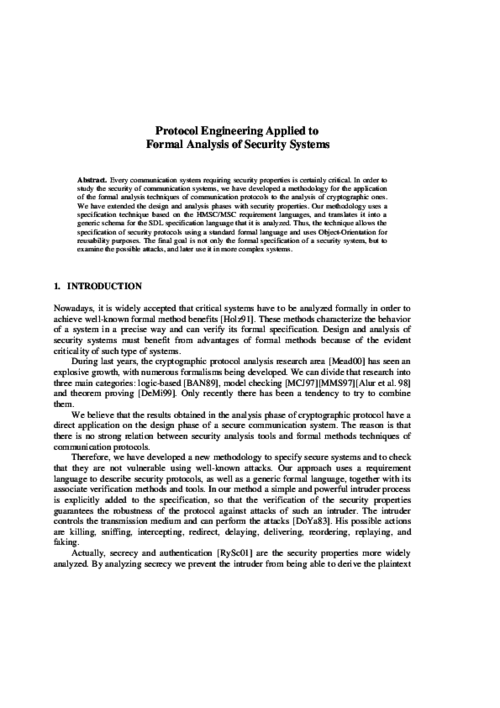 ] Title Type Year
] Title Type Year
Proceedings of the 7th International Conference on Network and System Security (NSS 2013)
, vol. LNCS, no. 7873, Springer, Jun 2013.
 |  |
IFIP Working Conference on User Identification and Privacy Protection, pp. 209-227, June, 1999.
Abstract
While there is wide agreement on the immense potential of Internet, its growth and performance are adversely affected by security issues. Despite its impressive size, scope and reach, the Internet has not yet become a common vehicle for many of these new possibilities. Progress in fields as electronic commerce and government-citizen relationships have been limited by the open design of the network itself. Today, Public-Key Infrastructures are the basis of the protocols and tools needed to guarantee the security demanded in those fields. Trust management and user identification are also important issues that remain unresolved. This paper introduces a key management and user identification system, named Cert’eM, that is based on the electronic mail service. Cert’eM provides important advantages over existing Public-Key Infrastructures and user identification proposals.
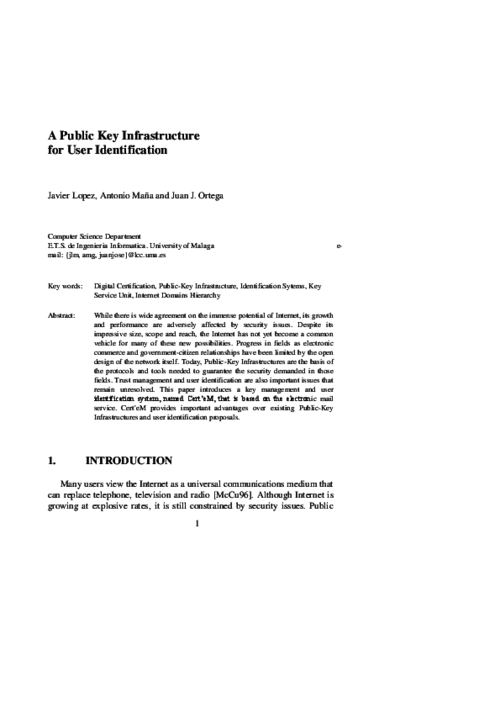
VII Reunión Española sobre Criptología y Seguridad de la Información (VII RECSI), pp. 485-497, Septiembre, 2002.
I Congreso Nacional Turismo y Tecnología de la Información y las Comunicaciones (TURITEC’99), pp. 99-110, Septiembre, 1999.
Abstract
Uno de los servicios que cada día cobra más importancia y que promete un cambio radical para las empresas es el comercio electrónico en Internet, pero tradicionalmente las empresas relacionadas con el turismo sólo han empleado la red para darse a conocer y ofertar sus productos. La razón esencial es la desconfianza que existe sobre la seguridad de las transacciones llevadas a cabo en la red. La criptografía de clave pública proporciona servicios adecuados para garantizar la seguridad de esas transacciones. Pero en la actualidad, algunos de esos servicios están menos desarrollados que otros; un ejemplo de ellos es el servicio de No-Repudio. En este artículo se estudian distintas formas de ofrecer servicios de no-repudio y se analizan sus ventajas y desventajas en función de las necesidades del entorno en que se utilicen.
International Journal of Information Security (IJIS), vol. 2, no. 2, Springer, pp. 91-102, 2004.
Abstract
Public-Key Infrastructures (PKIs) are considered the basis of the protocols and tools needed to guarantee the security demanded for new Internet applications like electronic commerce, government-citizen relationships and digital distribution. This paper introduces a new infrastructure design, Cert’eM, a key management and certification system that is based on the structure of the electronic mail service and on the principle of near-certification. Cert’eM provides secure means to identify users and distribute their public-key certificates, enhances the efficiency of revocation procedures, and avoids scalability and synchronization problems. Because we have considered the revocation problem as priority in the design process, and with a big influence in the rest of the PKI components, we have developed an alternative solution to the use of Certificate Revocation Lists (CRLs), which has become one of the strongest points in this new scheme.
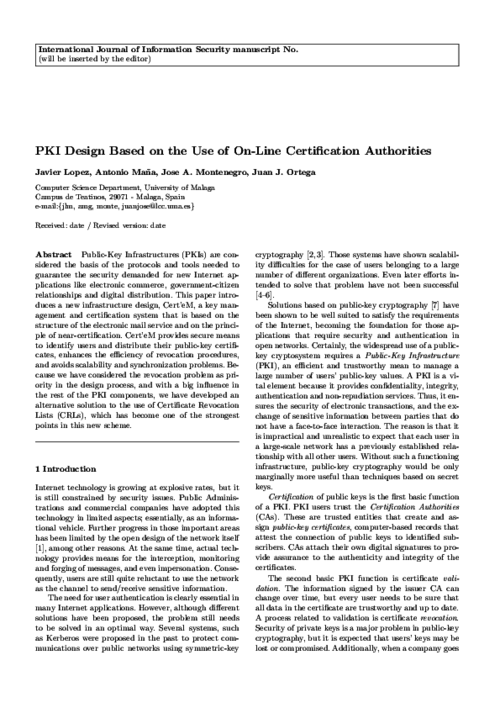
Revista SIC: Seguridad en Informática y Comunicaciones, vol. 49, pp. 1-2, 2002.
|
"Public Key Infrastructure, 4th European PKI Workshop: Theory and Practice, EuroPKI 2007, Palma de Mallorca, Spain, June 28-30, 2007, Proceedings", EuroPKI, vol. 4582, Springer, 2007.  |  |
European CIIP Newsletter, vol. 11, issue 26, no. 1, European CIIP Newsletter, pp. 27-29, 03/2017.
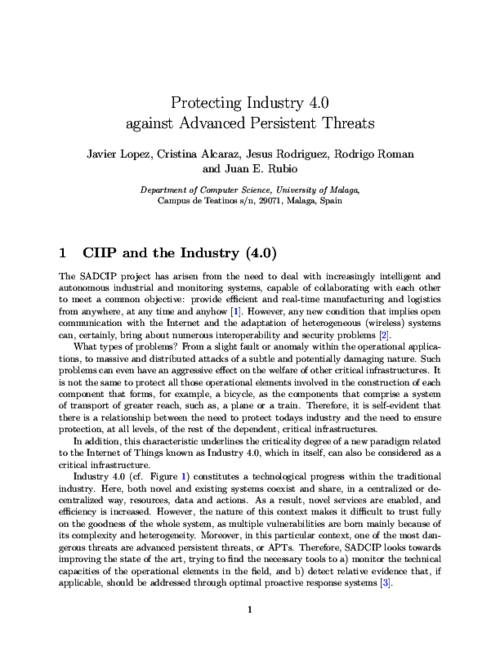
I Congreso Internacional Sociedad de la Información, pp. 423-428, 2002.
Abstract
The important role of Public Key Infrastructures (PKIs) inside the general scope of Internet communication, and more precisely, inside electronic commerce, has driven us to the revision of actual procedures followed in the development of software of these elements that provide security and trust to the digital certification environment. In this work we introduce the actual results of a joint research project of the Security Group of the University of Malaga and the Department of Technology Innovation of Banesto regarding a PKI implementation. The originality of this work is that we have paid attention not only to functional aspects of the infrastructure, but also to the programming techniques used. Basically, we have developed a solution in which implementation has been guided by the increase in the study of software architectures and those paradigms that have emerged in parallel, as component orientation, software frameworks, and design patterns. The correct use of these techniques provide a different point of view that allows the development of every PKI building block in a modular and independent way.
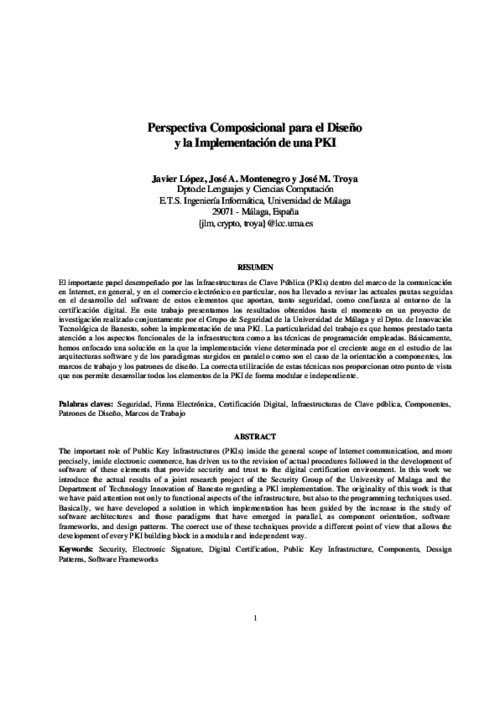
On Foundations of Security Analysis and Design IV, FOSAD 2006/2007, Springer, LNCS 4677, pp. 160-182, 2007. DOI
Abstract
Critical Infrastructures are complex and highly interconnected systems that are crucial for the well-being of the society. Any type of failure can cause significant damage, affecting one or more sectors due to their inherent interdependency. Not only the infrastructures are critical, but also the information infrastructures that manage, control and supervise them. Due to the seriousness of the consequences, the protection of these critical (information) infrastructures must have the highest priority. It is the purpose of this book chapter to review and discuss about these infrastructures, to explain their elements, and to highlight their research and development issues. This chapter will also discuss the role of Wireless Sensor Network (WSN) technology in the protection of these infrastructures.
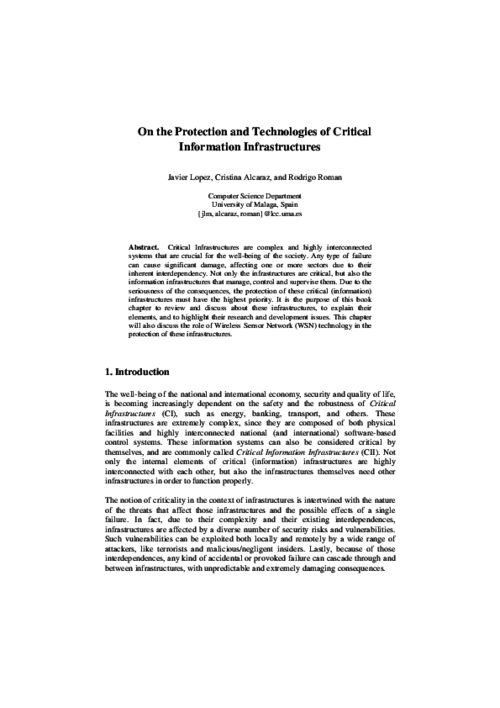
Information Security Practice and Experience (ISPEC 2014), vol. 8434, Springer, pp. 15-27, 05/2014. DOI
Abstract
Wireless sensor networks (WSNs) are exposed to many different types of attacks. Among these, the most devastating attack is to compromise or destroy the base station since all communications are addressed exclusively to it. Moreover, this feature can be exploited by a passive adversary to determine the location of this critical device. This receiver-location privacy problem can be reduced by hindering traffic analysis but the adversary may still obtain location information by capturing a subset of sensor nodes in the field. This paper addresses, for the first time, these two problems together in a single solution
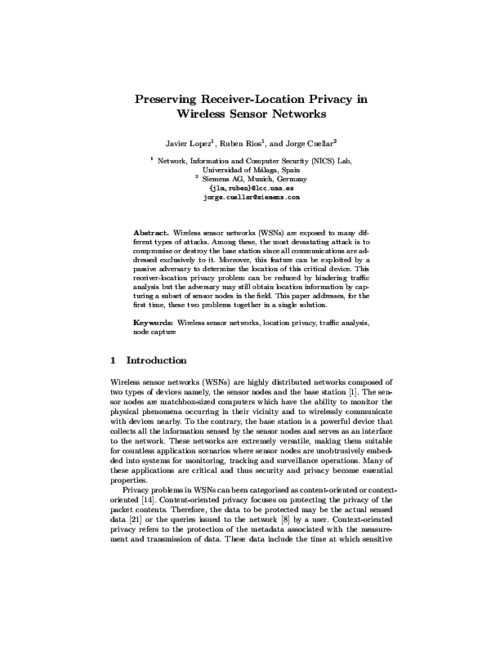
International Conference on Infrastructure Security (InfraSec’02), LNCS 2437, Springer-Verlag, pp. 246-259, October, 2002.
Abstract
Every communication system requiring security properties is certainly critical. In order to study the security of communication systems, we have developed a methodology for the application of the formal analysis techniques of communication protocols to the analysis of cryptographic ones. We have extended the design and analysis phases with security properties. Our methodology uses a specification technique based on the HMSC/MSC requirement languages, and translates it into a generic schema for the SDL specification language, which is used for the analysis. Thus, the technique allows the specification of security protocols using a standard formal language and uses Object-Orientation for reusability purposes. The final goal is not only the formal specification of a security system, but to examine the possible attacks, and later use the specification in more complex systems.
